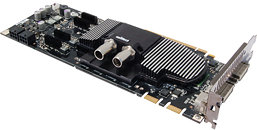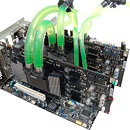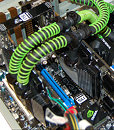Sunday, June 3rd 2007

Swiftech releases new block for NVIDIA GeForce 8 series
Named after the famous Stealth fighter bomber because of its angular shapes and black livery, Swiftech's Stealth is a VGA water-block designed exclusively for nVidia's high-end GeForce 8 series graphics cards. At the time of publication, the Stealth is compatible with the 8800 GTS, GTX and Ultra models.
The ultimate GeForce cooling performance:
Using the same core cooling technology as the Apogee GT and GTX CPU water-blocks which are recognized as the best performing water-blocks on the market, the Stealth unique design approach focuses cooling where it is most needed: at the GPU level; with its extended wings covering the memory modules and NVIO chip, the massive aluminum housing also maintains the lowest possible temperature of these surface mount components; this allows in effect for the most advanced overclocking techniques which are necessary to take core and memory frequencies well beyond factory specifications.
Source:
Swiftech
The ultimate GeForce cooling performance:
Using the same core cooling technology as the Apogee GT and GTX CPU water-blocks which are recognized as the best performing water-blocks on the market, the Stealth unique design approach focuses cooling where it is most needed: at the GPU level; with its extended wings covering the memory modules and NVIO chip, the massive aluminum housing also maintains the lowest possible temperature of these surface mount components; this allows in effect for the most advanced overclocking techniques which are necessary to take core and memory frequencies well beyond factory specifications.



12 Comments on Swiftech releases new block for NVIDIA GeForce 8 series
One thing that disturbs me with this block, tho, is the use of aluminum. Aluminum and copper don't play nice together in water setups. I think delrin or something similar would've been the better way to go.
The block on the first card will get noticeably less flow, because water takes the path of least resistance, and that would be straight instead of a right angle turn at each of those T-lines they've used.
When I saw this block I got excited, then I found out it's got aluminium and my search for a high-flow 8800GTS block that also cools the NVIO chip while rivaling my MCW60 goes on.
If the block is the bottleneck for flow, then having both blocks on there would give you equivilant flow, assuming input and output are the same right?
Instead of just brute forcing all the water you can through, its artificially bottlenecking the flow?
Similar to parallel in electricity, when you have 2(equal) resistances in parallel, you get 1/2 the resistance.
2 lanes pushing 6 cars for a total of 12 cars of flow
Vs 1 lane of 12 cars
It would work if the block isn't cooling limited with X amount of flow iirc?
The T-Design isnt all bad. Water does take the least resistance, but its liquid and as such, the state allows it to flow everywhere. The idea behind the design here is that water circulates and as the pressure goes, it will allow it to hit the gpus then cycle back up and continue on its way. The only draw back is, not all the heat will be disapated.
Other than that, its a nice looking block. I love swiftech, even though I dont own one, they are a top notch watercooling setup.
Remember, flow rate, and temperatures are HUGE variables, and can yield multiple different results with multiple pumps.